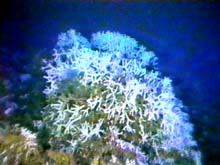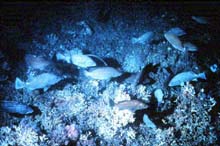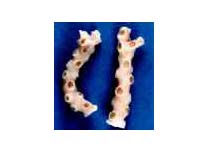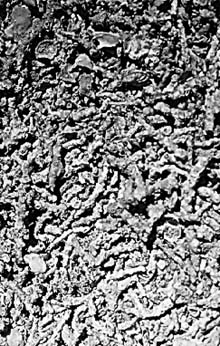
Oculina varicosa grows in thicket-like patterns and provides a unique habitat off the coast of Florida. Click image for larger view.
A Profile of Oculina Banks Reserve
Chris Koenig
Florida State University
Description
Fifteen to thirty miles off the central east coast of Florida in water depths of 70 to 120 m there exists a series of pinnacles and ridges that extend from Ft. Pierce to Cape Canaveral. These 10 to 20 m high pinnacles, derived from ancient shoreline features, form the foundation of a unique habitat structured by the ivory tree coral, Oculina varicosa. The thicket-like growth pattern of Oculina on these pinnacles provides complex interstices that allow high biodiversity and also provide important spawning sites for many species including economically important groupers. Unfortunately, much of the Oculina habitat is completely destroyed. Oculina habitat loss is at least in part due to trawling and much of the loss occurred over 25 years ago. Now, the entire Oculina Banks, some 300 square miles, have been set aside as a Habitat Area of Particular Concern (HAPC) by the South Atlantic Fishery Management Council. The HAPC designation protects the remaining habitat from mobile fishing gear and from other potentially damaging mechanical impacts. In addition, the lower portion of the HAPC, called the Experimental Oculina Research Reserve (EORR), was closed to bottom fishing in 1994 for a period of 10 years to allow scientific studies on the recovery of fish populations and grouper spawning aggregations. Habitat restoration began in 2000 and one of the objectives of the Islands in the Stream Expedition to the Oculina Banks is to evaluate the short-term success of this restoration effort.

The highly prized species of grouper, gag and scamp, form large spawning aggregations in Oculina habitat in February and March. Click image for larger view.
Research and Education Objectives
Populations of fish on the Oculina Banks observed prior to significant fishing of the area were impressive. Gag, scamp, Warsaw groupers, snowy groupers, speckled hind and amberjack were abundant and large. When observed from a submersible in 1995, after a decade of intense fishing, the Banks were depleted and only a few small fish remained. Most disturbing was the observation that the massive grouper spawning aggregations were reduced to just a few small individuals. A priority objective, therefore, is to observe the present condition of the fish populations in the EORR after seven years of closure to bottom fishing. Other research objectives include the mapping of live versus destroyed Oculina habitat, comparison of present habitat conditions with those observed 20 to 25 years ago, and quantitative characterization of the living habitat. The effectiveness of restoration efforts will also be evaluated.
The Islands in the Stream Expedition will provide to the public images and information about the magnificent Oculina habitat and pinnacle features existing just a few miles off Florida’s east coast. Public awareness of the nature of the habitat, its vulnerability, and value is the first step in effective stewardship.
Daily logs and photographs will be posted on the Ocean Explorer Web site.

In depths of 50 m or greater, Oculina varicosa lacks zooxanthellae, the symbiotic algae that give corals their color and part of their nutrition; thus, the coral is white at these depths and relies solely on plankton for food.
Key Species
- Ivory tree coral (Oculina varicosa): coral that creates the structural foundation of the habitat.
- Gag (Mycteroperca microlepis): grouper form spawning aggregations in late winter and spring.
- Scamp (Mycteroperca phenax): grouper form spawning aggregations in late winter and spring.
- Speckled hind (Epinephelus drummondhayi): grouper, common in the 1970s.
- Snowy grouper (Epinephelus niveatus): grouper, common in the 1970s.
- Warsaw grouper (Epinephelus nigritus): very large grouper, commonly seen in the 1970s.
- Roughtongue Bass (Pronotogrammus martinicensis): small bass, very abundant.
- Red Barbier (Hemanthias vivanus): small bass, very abundant.
- Yellowtail reef fish (Chromis enchrysurus): small damselfish, very abundant.
Protected Areas
Name |
Area (nm2) |
Date Established |
Comments |
| Experimental Oculina Research Reserve | 92 |
1994 |
- 10 year closure - year-round - closed to bottom fishing - anchoring prohibited |
| Oculina Banks HAPC (including two small, 3 nm2, satellite HAPCs) | 300 |
2000 |
- permanent protection
|

Much of the Oculina habitat of the Oculina Bank is reduced to rubble, likely due to trawling more than 25 yrs ago.
Interesting Facts
- Oculina varicosa occurs in depths of several meters to greater than 100 meters. In shallow depths colonies are relatively small with stout club-like branches whereas in greater depths colonies may be up to several meters in diameter and clustered in a thicket-like habitat.
- In depths of 50 m or greater Oculina varicosa lacks zooxanthellae, the symbiotic algae that gives corals their color and part of their nutrition; it is therefore white at these depths and relies solely on planktonic food.
- Scientific studies have shown a very high diversity of mollusks and crustaceans, with hundreds of species represented in the interstices of the Oculina coral heads.
- Other studies showed that highly prized species of grouper, gag and scamp, form large spawning aggregations in Oculina habitat in February and March.
- Much of the Oculina habitat of the Oculina Banks is reduced to rubble. The direct causes of this habitat destruction are likely related to trawling, but other anthopogenic causes and possibly environmental factors may also be responsible. Foreign trawlers operated on the east Florida shelf before the Magnuson Act of 1976 and American trawlers targeted rock shrimp and scallops after this time.
- Restoration of destroyed Oculina habitat is presently underway, but because of the slow growth rate of Oculina, 1 to 2 cm per year, the successful establishment of Oculina thickets, if it occurs, will take decades.
Sign up for the Ocean Explorer E-mail Update List.











































